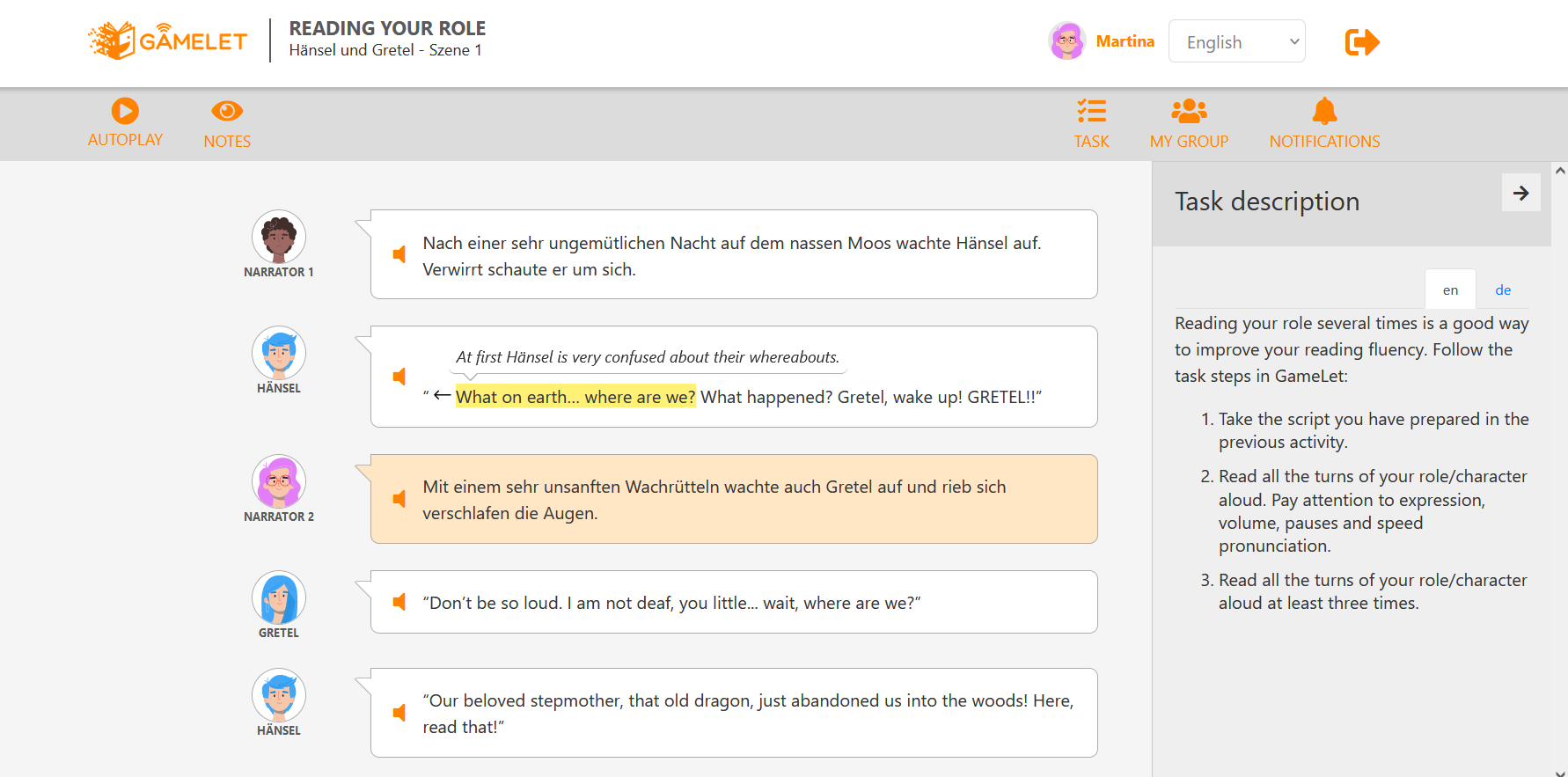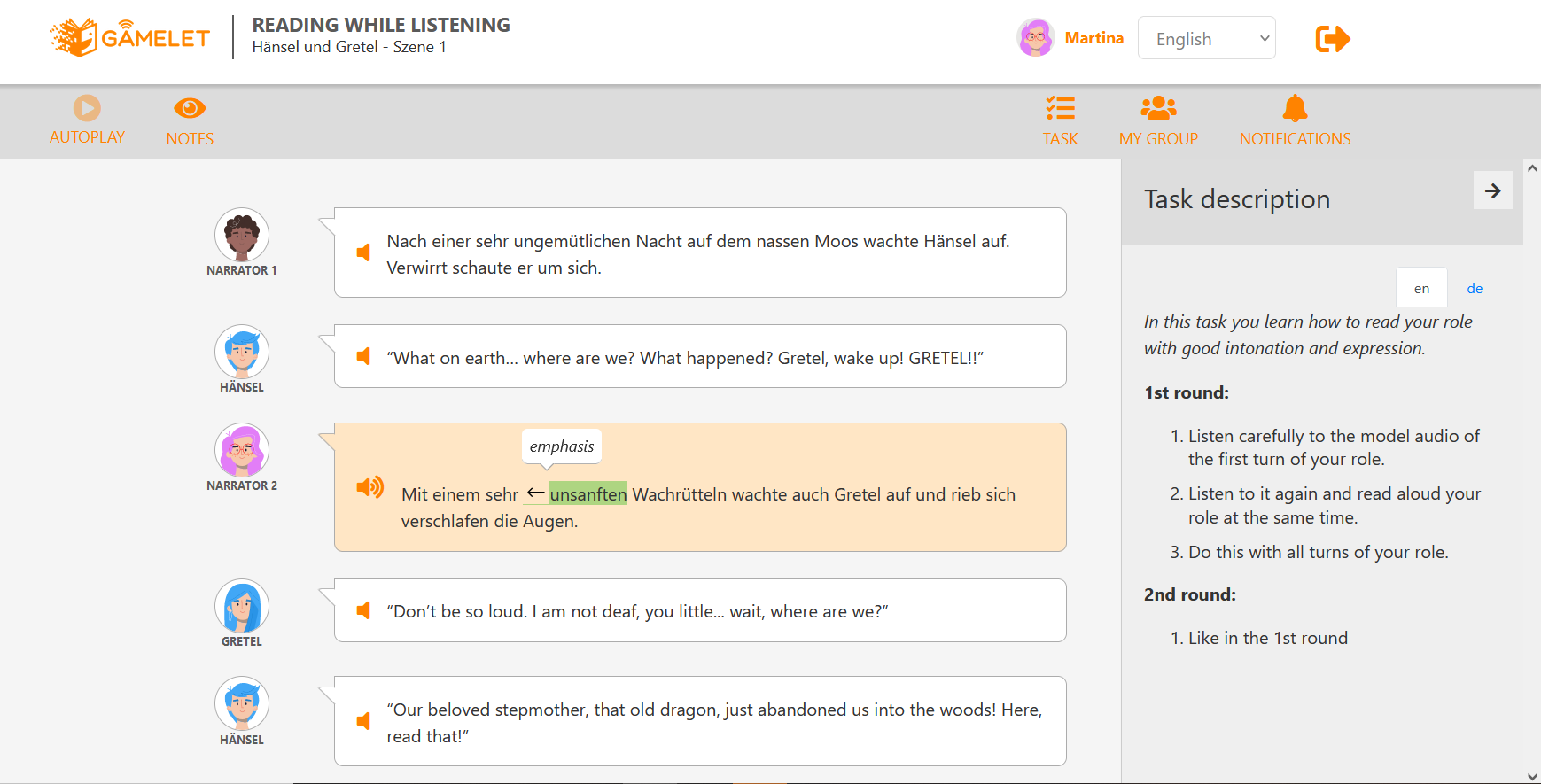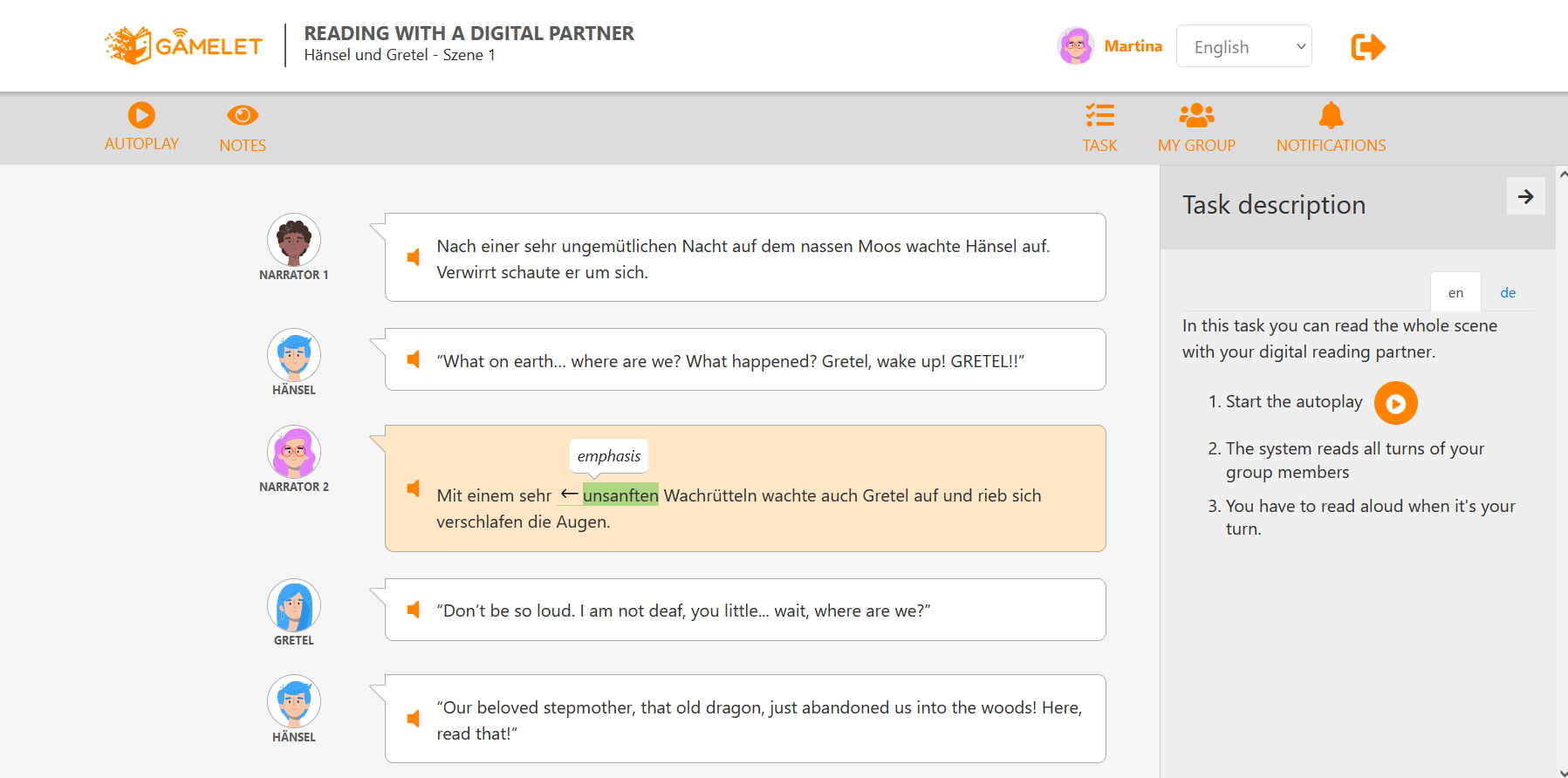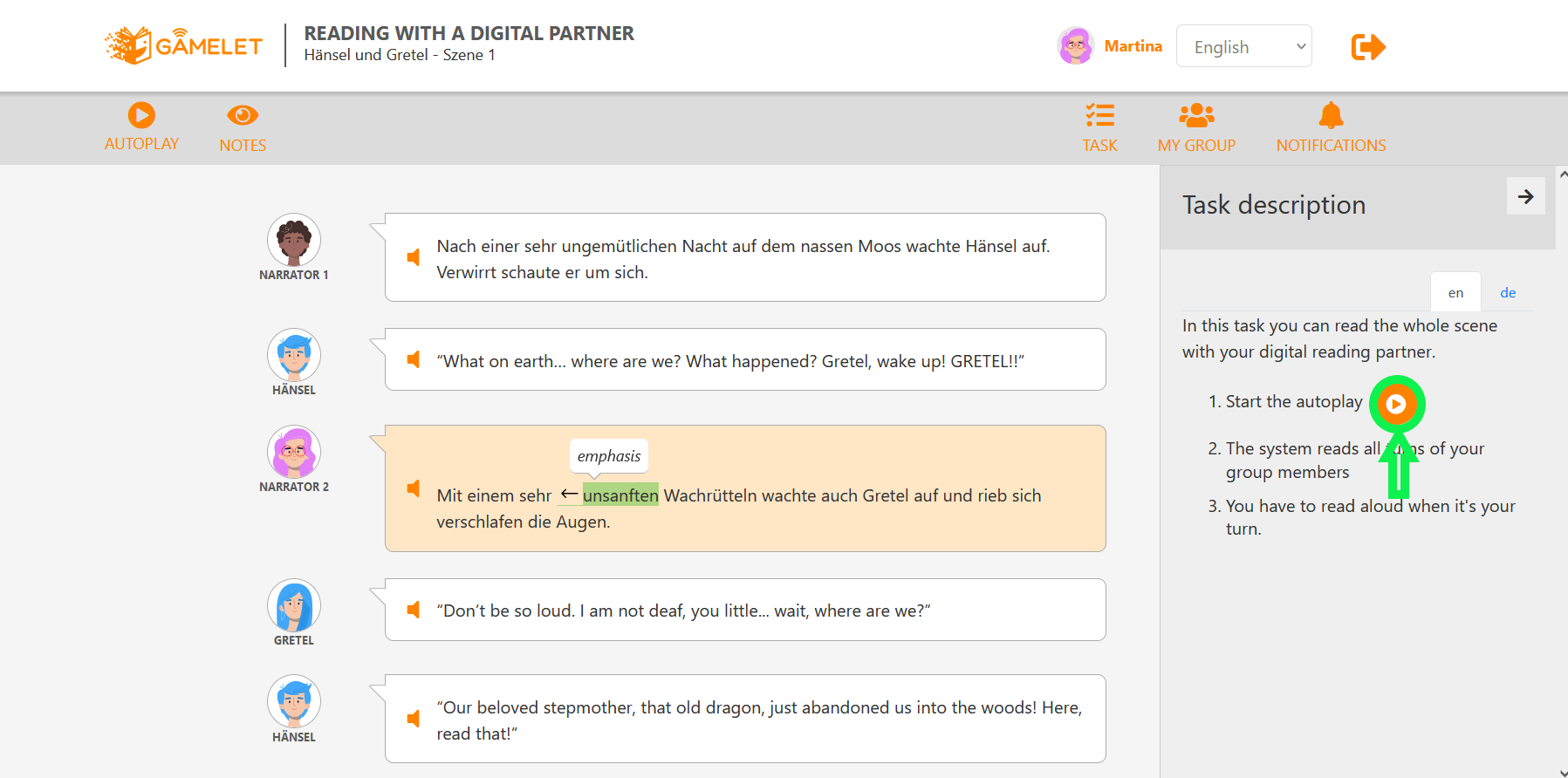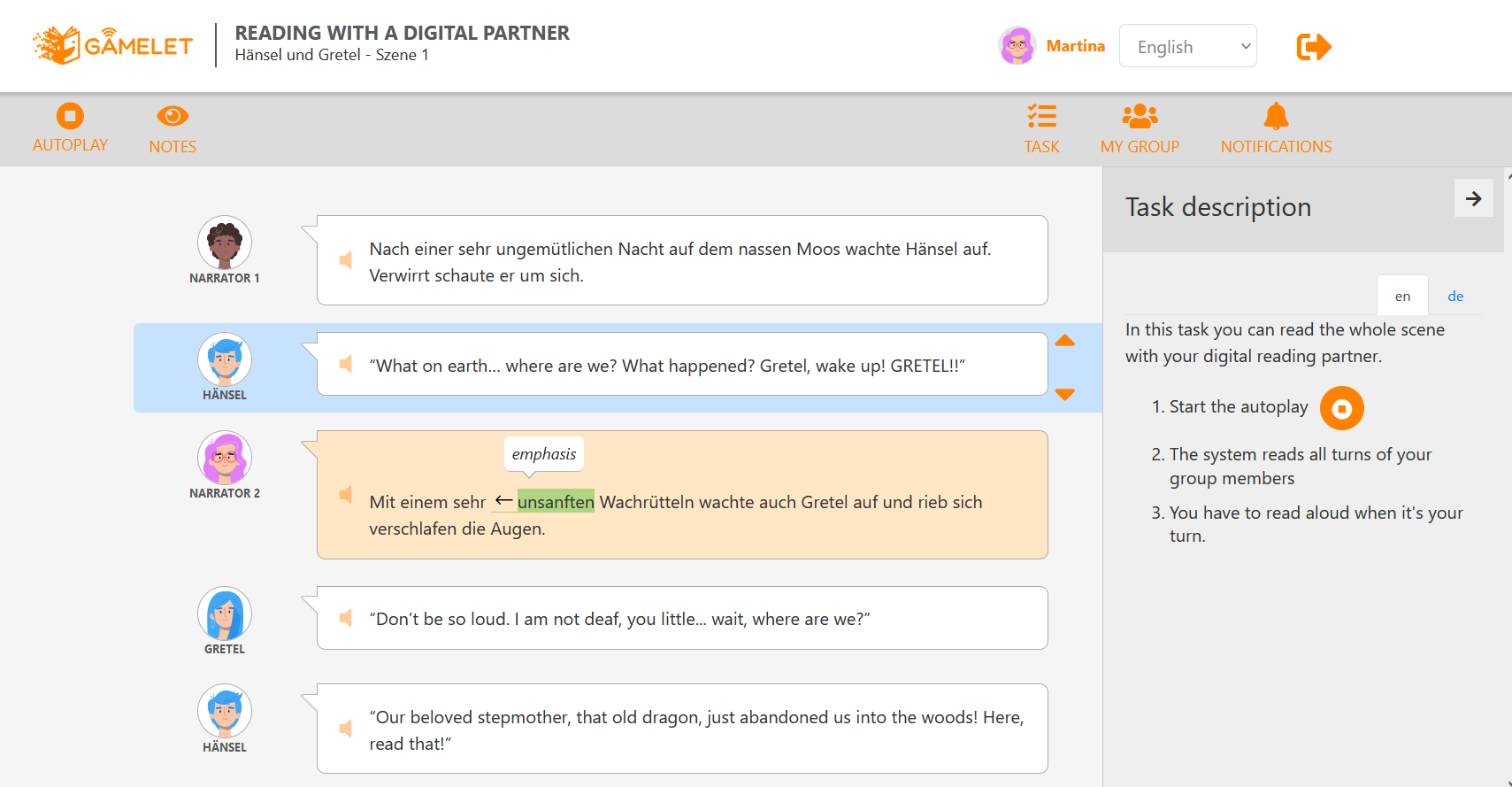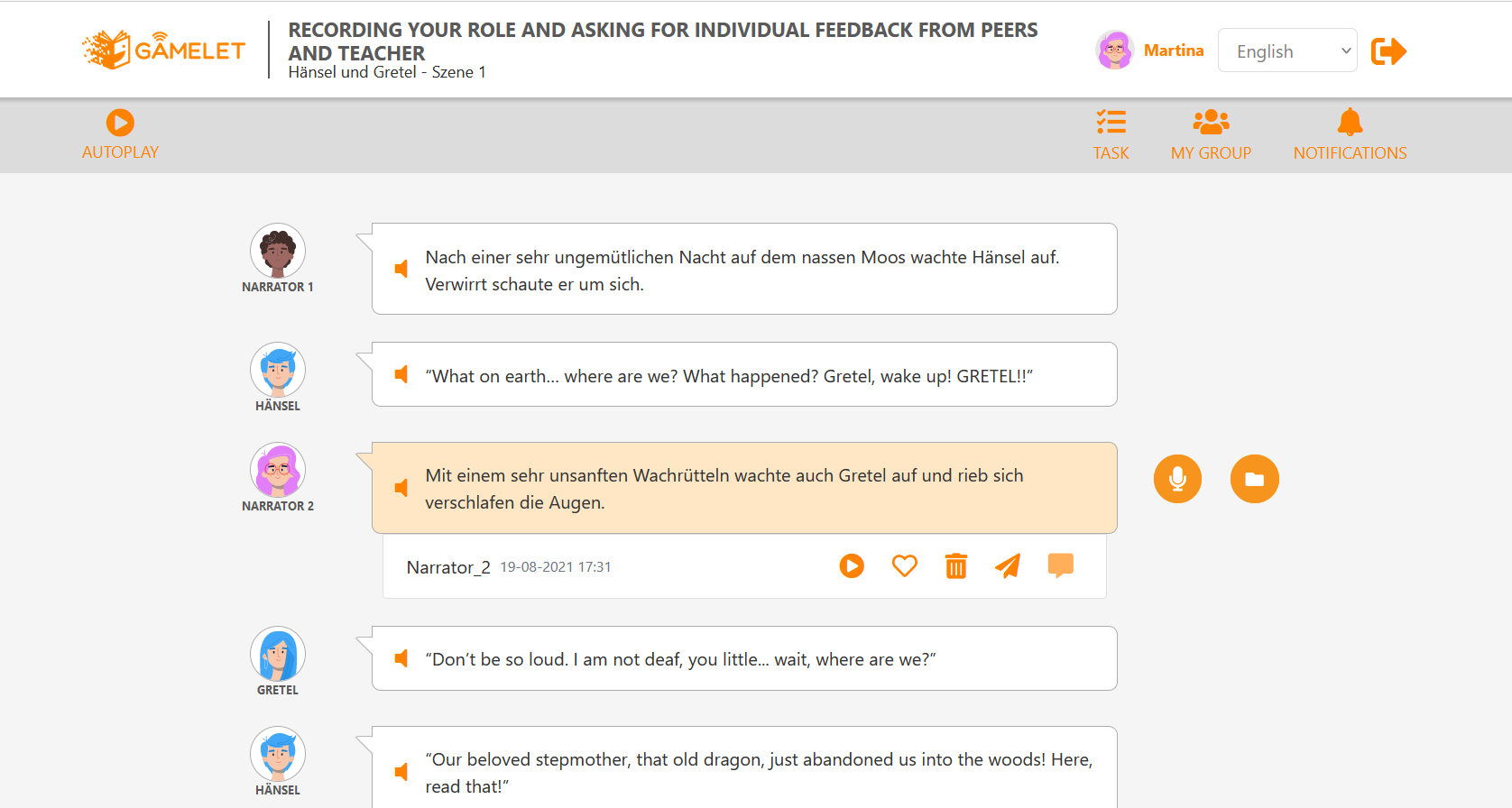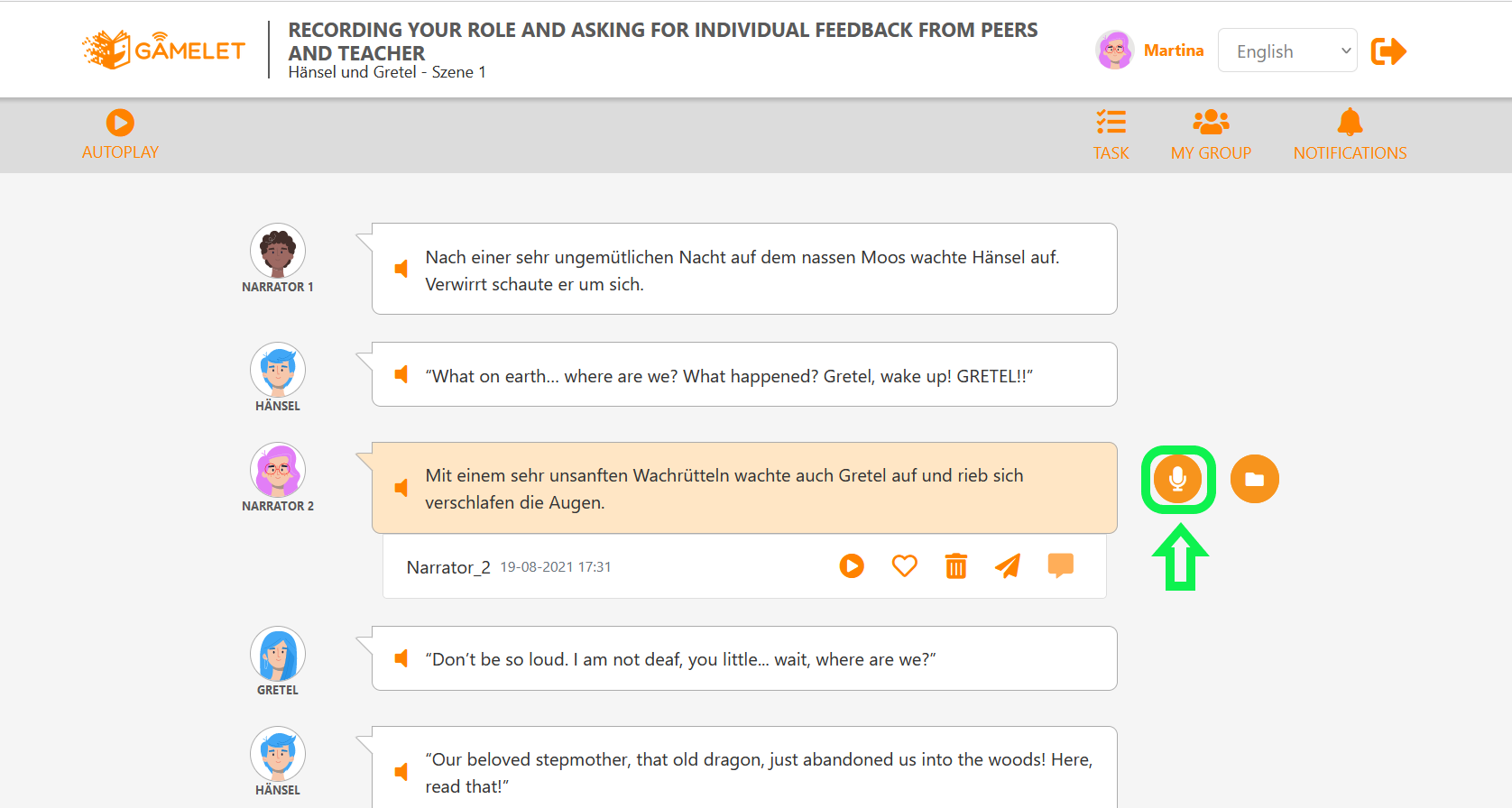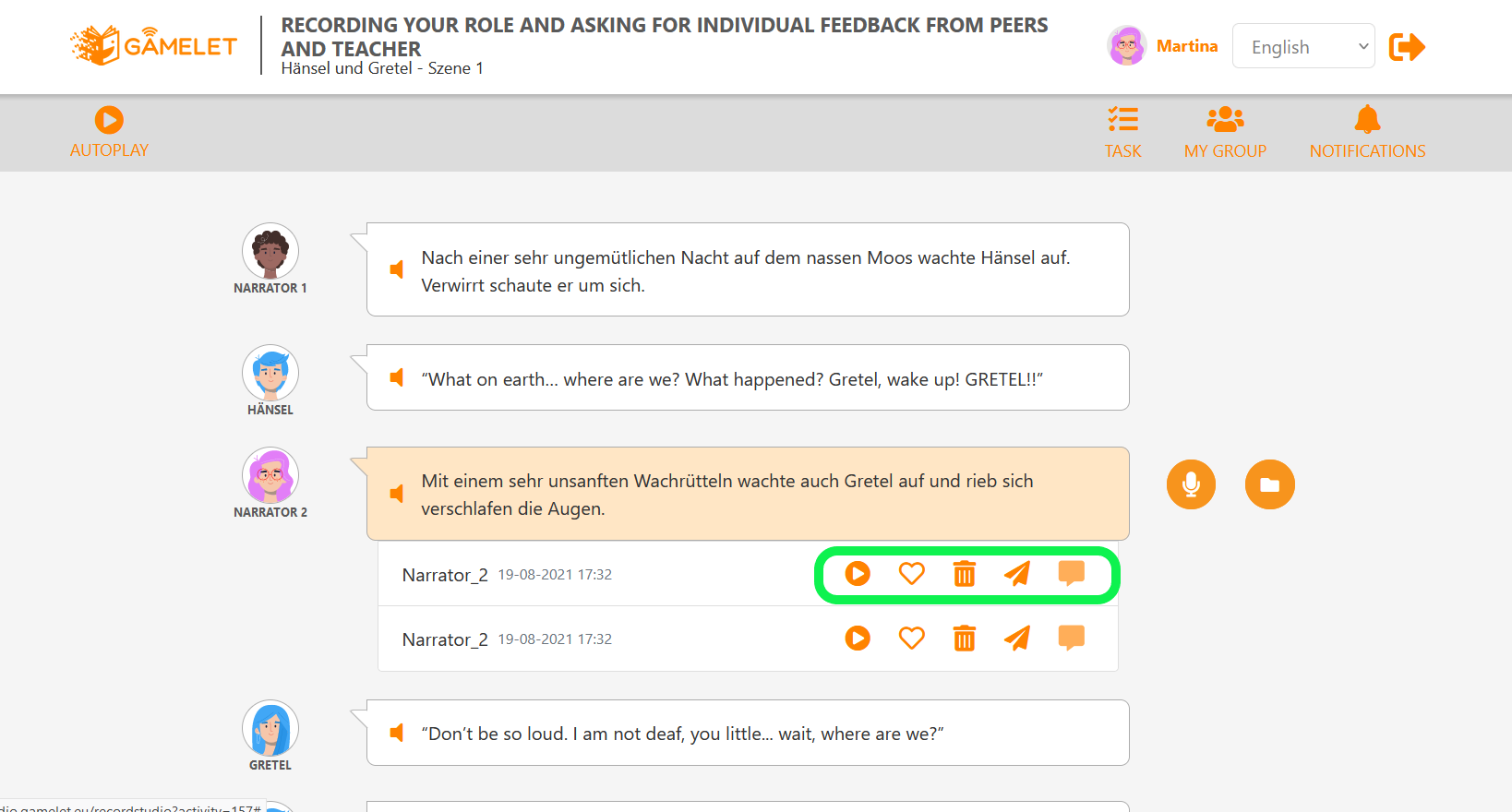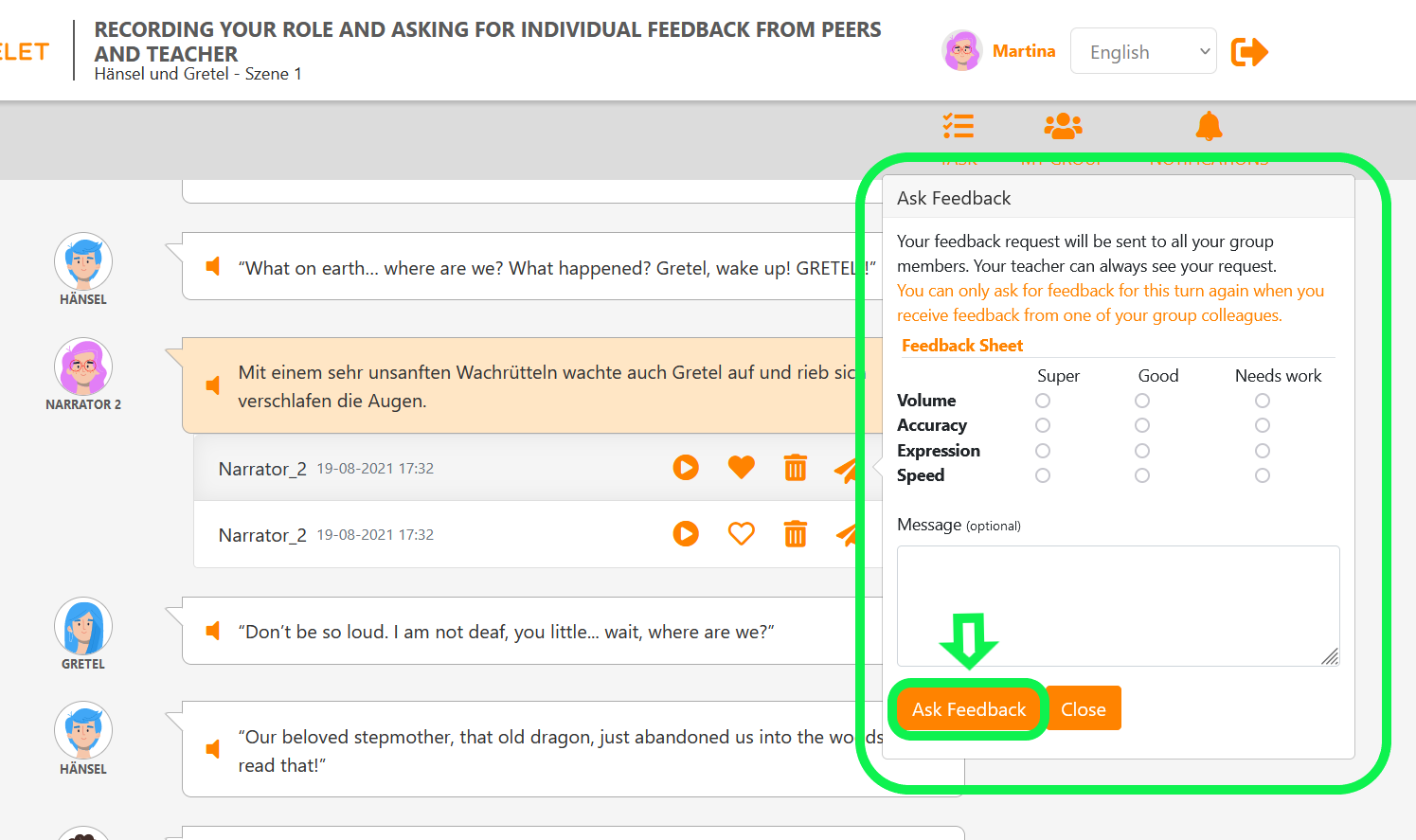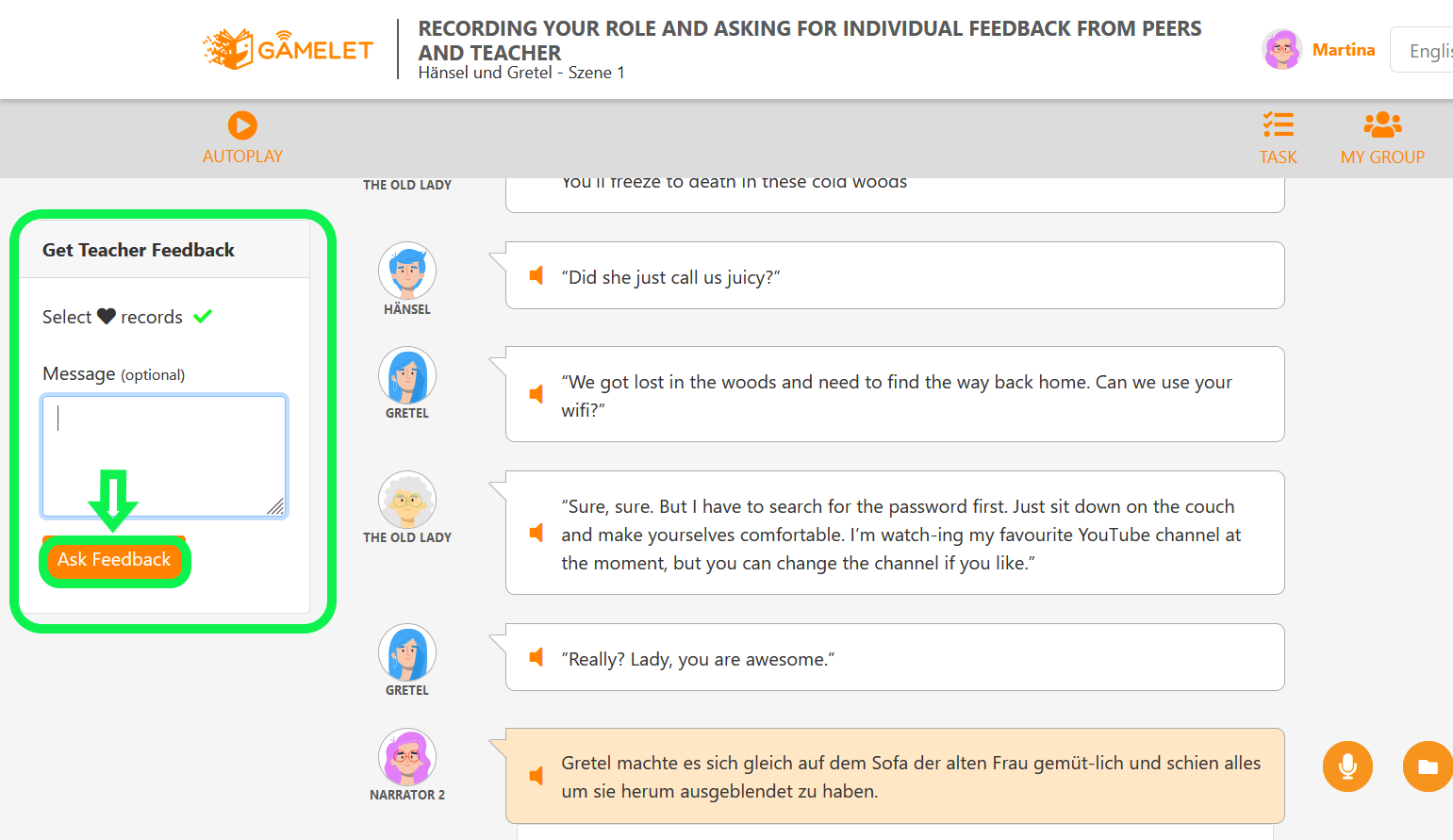5.4.2. Introduction to individual practice
Methodological commentary
Individual Practice is an important and effective way to improve student reading fluency. Repeated Reading is a method aimed at automating reading skills of decoding single words and sentences. With increased automatization and repetition at the word and sentence level, learners have more cognitive resources available to do an in-depth analysis of the text. Moreover, a good understanding of the scene in question improves the overall prosodic composition of reading.
This overview introduces a variety of individual practise exercises, so that students may choose different ways to practice their roles. Upon completion of these tasks, learners will have experienced different individual training methods and improved their reading considerably.
After having practised intensively, learners record their role several times until they are satisfied with their results. Then, they choose their best turn and send it to the teacher and their group members for feedback. Focused attention to performance and recognition of assistance are excellent means for strengthening awareness of good reading aloud ability.
Task description
Learners practice reading their script on their own at home. They are required to carry out the following tasks:
a. Reading your role
| Short task description | Learners practice reading their roles aloud |
|---|---|
| Aims | Foster reading fluency |
| Social format | Individual |
| Synchronous/ asynchronous mode |
Asynchronus |
| Feedback | none |
| Time needed | Dependent on the individual learning level (approximately 10 minutes) |
Task description
Learners practice their role. They move from their first turn to the second and so on. They should repeat the task at least 3 times.
Using the game
Reading your role several times is an excellent way to improve your reading fluency. Follow the task steps in GameLet:
- Use the script you have prepared in the previous activity.
- Read all of your role/character turns aloud. Pay attention to expression, volume, pauses, speed, and pronunciation.
- Read all of your role/character turns aloud at least three times.
Awarding points: 50 points
b. Reading while listening
| Short task description | Learners practice reading their role aloud by means of an audio model. |
|---|---|
| Aims | Fostering reading fluency; imitating model intonation, emotion and expression. |
| Social format | Individual |
| Synchronous/ asynchronous mode |
Asynchronus |
| Feedback | none |
| Time needed | Dependent on the individual level of ability (approximately 15 minutes) |
Task description
Learners practise reading their roles along with the model reader. Later, learners read aloud with the listening text. They should practise their turns one at a time. Each turn should be repeated at least 3 times.
Using the game
In this task, you will learn how to read your role using good intonation and expression.
1st round:
- Listen carefully to your role’s first turn as played by the model audio.
- Now, read your role along with the model audio
- Finally, repeat steps 1 and 2 three times with all of your role turns
2nd round:
Like in the 1st round
3rd round:
Like in the 1st round
The system awards points when the users listened to all of their turns.
Awarding points: 50 points, additional 50 points can be awarded for doing the task again for a maximum of 100 (2x50) points.
c. Reading with a digital learning partner
| Short task description | Learners read the whole scene with the digital partner. In this way they may improve their reading by (i) listening to the digital reading model; (ii) reading the other roles; and (iii) reading their own turns. |
|---|---|
| Aims | Foster reading fluency by means of repetition |
| Social format | Individual |
| Synchronous/ asynchronous mode |
Asynchronus |
| Feedback | none |
| Time needed | Dependent on individual reading fluency level |
Task description
Learners improve their reading by (i) listening to the digital reading model; (ii) reading the other roles; and (iii) reading their own turns.
Using the game
In this task, you read your role with the digital reading partner who reads the other roles.
- Start the autoplay.
- The system reads your group member roles. Read along silently.
- When it is your turn, you read your own role aloud.
The system knows when the user reaches the end of the Reader’s Theatre.
Awarding points: 50 points, additional 50 points can be awarded for doing the task again for a maximum of 100 (2x50) points.
d. Individual feedback
1. Recording Your Role and Asking for Individual Feedback From Peers and Teacher
| Short task description | Learners practice reading their role, then record it and finally send it to their teacher and their group members for feedback. |
|---|---|
| Aims | Repeated reading |
| Social format | Individual |
| Synchronous/ asynchronous mode |
Asynchronus |
| Feedback | From the teacher and group members |
| Time needed | Dependent on individual learning level (approximately 15 minutes) |
Task description
Learners practice and record their role. They send their favourite recordings to their teacher and their group members for feedback.
Using the game
In this task, you will read your role using good intonation and expression. You will then select your best recording for teacher and group member feedback.
Step 1: Practice your turns until you are happy with them.
Step 2: Record your turns as many times as you think is necessary.
Step 3: Select the best recordings: ![]()
Step 4: Delete the recordings you do not like: ![]()
Step 5: Send single recordings to your group for feedback and ask questions: ![]()
Step 6: Send all of your recordings to your teacher: this is only possible after you have recorded all of your sentences. A message window will open automatically.
Awarding points: 50 points for recording and asking for feedback, additional 50 points can be awarded for doing the task again for a maximum of 100 (2x50) points.
2. Giving Peer Feedback
| Short task description | During the feedback phases, students give feedback to their group mates’ recordings. |
|---|---|
| Aims | Fostering students’ awareness for reading fluency by giving feedback. |
| Social format | Individual and collaborative |
| Synchronous/ asynchronous mode |
Asynchronus |
| Feedback | Giving peer feedback in form of a text message and/or audio message. |
| Time needed | Dependent on individual reading level and the ability to give feedback. |
Task description
During the feedback phases, students give feedback to their group members in the form of text and audio messages.
Using the game
Give feedback to at least two other students. Try to help as many students as possible.
- Look for feedback requests:

- Open the feedback request:

- A window for your feedback opens. To give feedback on the recording, tick the boxes and write a text message or record an audio message. (English or school language).
- Send your feedback.
Total possible points: 50 points
3. Receiving Feedback from Peers and Teacher
| Short task description | During these phases, students receive feedback on their recordings from their peers and teacher. |
|---|---|
| Aims | Improve reading fluency by means of feedback |
| Social format | If possible collaborative, otherwise individual |
| Synchronous/ asynchronous mode |
Asynchronus |
| Feedback | Receiving feedback in the form of a text message and/or audio messages. |
| Time needed | Dependent on feedback |
Task description
During this phase, students receive feedback on their recordings.
Using the game
- Look for feedback here:

- Open your feedback:

- Check the rating you have received by reading the text message and/or listening to the audio feedback.
- Reflect on your feedback: How can you improve your reading?
Total possible points: 50 points for given feedback
e. Hiking
| Short task description | Learners will plan a hiking route through their favorite room at home. Learners will hike around the room while reading their script out loud. During the hike, learners follow their planned route, while repeatedly reading their roles.. |
|---|---|
| Aims | Foster reading fluency by means of physical activity |
| Social format | Individual |
| Synchronous/ asynchronous mode |
Asynchronus |
| Feedback | N/A |
| Time needed | The time frame for task completion is set by the teacher (for example: one week) |
Task description
After printing out their scene script and choosing a room, learners should collect and place objects that can serve as obstacles (e.g., mountains, rocks, rivers, animals, etc.) around the room. Learners then begin planning a detailed hiking route that includes the start and end of the hike, how to maneuver around, or over the obstacles. The hiking plan is then drawn by hand and named (e.g., The Goat Trail, etc). Naturally learners should be encouraged to create a safe route which avoids dangerously tight spaces, tripping over electric cables, or upturning tables, etc. While hiking, learners should read their roles repeatedly. The hike and reading should be completed at least 3 times.
Using the game
You need:
- a printout of your scene script
- obstacles in your room to hike around
- the Moodle forum
- Prepare a “hike” through your favourite room.
- Imagine there are trees, rivers, hills, etc. in your room.
- Use objects such as chairs, books, blankets, etc. that should represent the various obstacles.
- Choose the starting point of your hike and plan your way over the hills, through the rivers, etc.
- Be careful, avoid potential dangers such as electric cables or tight spaces between furniture.
- Let’s start your hike!
- While hiking, read your text aloud.
- Repeat your hike and script reading at least 3 times.
- Write down how many hikes you completed.
Total possible points: 50 points
f. Climbing the mountain of fluency
| Short task description | Learners read their roles several times on their own while timing themselves. With each repetition learners are given instructions for body postures and voice changes. |
|---|---|
| Aims | Repeated reading |
| Social format | Individual |
| Synchronous/ asynchronous mode |
Asynchronus |
| Feedback | Indirect feedback by means of reading time comparisons |
| Time needed | Dependent on individual reading level; minimum of three reading rounds |
Task description
Learners should read their roles several times while timing their reading pace with a stopwatch. Each time the learners read their role, they should follow the instructions for body posture and voice type This activity is meant to make reading practice more fun for learners. (or: this activity is meant to reduce the possibility of boredom caused by repetitiveness. First, the learners are instructed to lay on the floor and whisper their reading role. Secondly, while still on the floor, they should sit up and read the text with a semi-loud voice. Thirdly, they should sit on their knees and read in a normal volume. Finally, they should stand up and read loudly. After all four rounds have been completed, learners write down the time it took them to move through all positions, after which they start the procedure all over again.
In round two, learners should alter their voices from a deep to a high pitch each time they change their physical positions.
In round three, learners are given the opportunity to determine their voice pitch and volume for each of the physical positions.
To complete the activity, learners should do at least three rounds, and compare the time it took to read their roles. Here learners should be able to recognise their own reading time improvement. This activity can be highly motivating because it acts as direct feedback of reading time and improvement. Moreover, the side-effect of reading speed is accuracy. Learners may revisit this activity at any time with the Gamelet. In this way, they can receive direct feedback on their reading improvement.
Using the game
You need:
- A printout of your reading role/scene (or: a printout of your role script)
- Timesheet and a pen
- Stopwatch (analogue or digital)
Let’s climb the mountain of fluency!
- Place your script, timesheet and stopwatch next to you on the floor
- Make sure you have enough space to move around. Get ready to stop your reading time.
- Try to read your role correctly and with good intonation. This activity is not only about speed!
Round 1:
- Lay down on the floor and read your text in a whisper.
- Sit up on the floor and read the text again in a semi-loudly.
- Sit on your knees and read your text in a normal volume.
- Stand on your feet and read quite loudly. But don’t scream!
Stop your time and write it down on your timesheet.
Round 2:
- Lay down on the floor and read with a very deep voice.
- Sit on the floor and read with your normal voice.
- Sit on your knees and read with a high voice.
- Stand on your feet and read with a very high voice.
Stop your time and write it down on your timesheet.
Round 3:
- For the four steps, choose the voice you will read for each of the positions
- Stop your time and write it down on your timesheet.
Compare your times. Can you read better? Can you read faster?
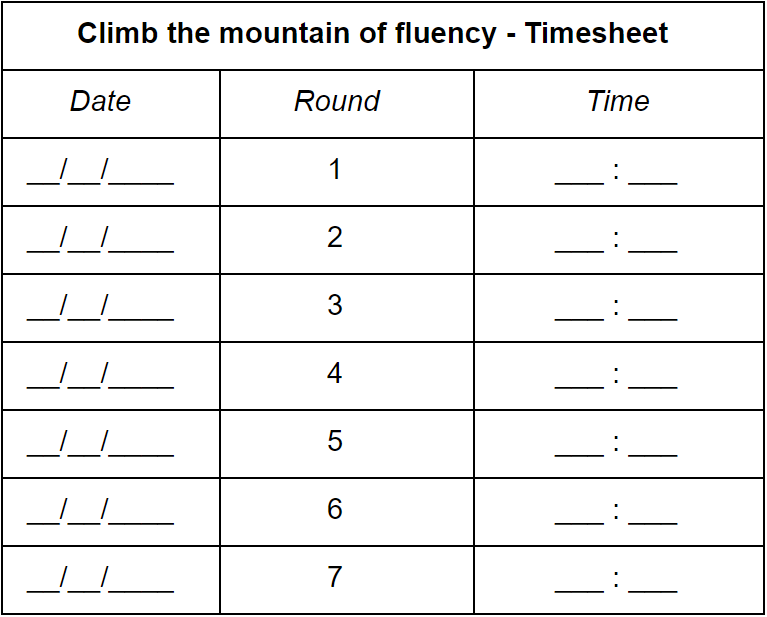
Awarding points: 50 points
g. Recording your role in a funny way
| Short task description | As a means for greater reading practice motivation, learners are asked to engage in a funny voice distorting activity. |
|---|---|
| Aims | To motivate increased reading practice by making the task more varied and entertaining. |
| Social format | Individual |
| Synchronous/ asynchronous mode |
Asynchronus |
| Feedback | none |
| Time needed | Approximately 15 minutes - script dependent |
Task description
Learners practise their scenes individually. For this task, learners choose to distort their voices in a funny way when reading their roles. These recordings are then shared with peers and/or the teacher.
Using the game
- Select at least 4-6 turns.
- Practice them using a funny voice.
- Record at least 3 of your turns. If you don’t like a recording, you can make a new one.
- Finally, send your favourite turns to your group members and your teacher.
Awarding points: 50 points
